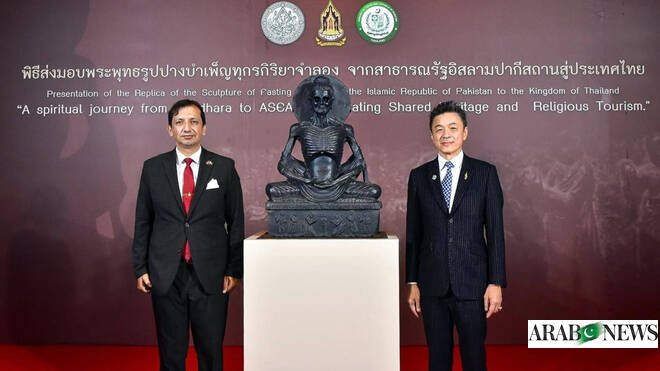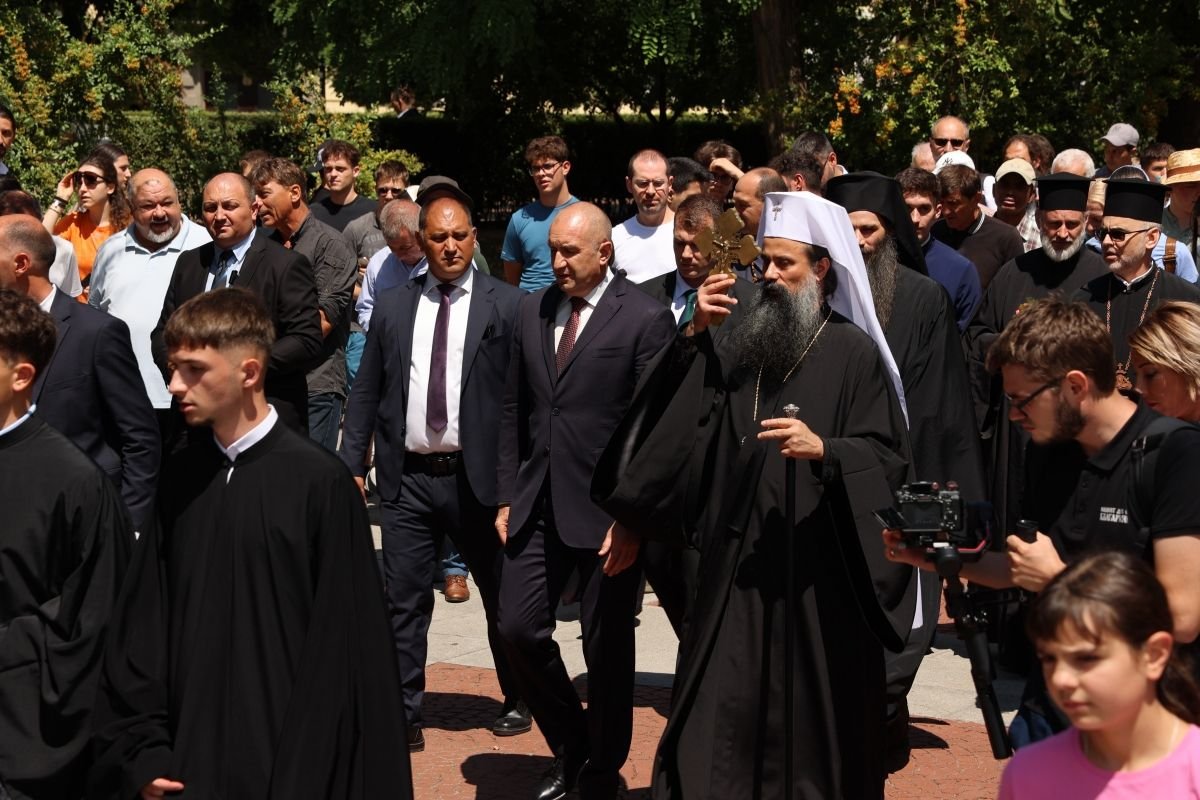Spiritual Travel
Pakistan gifts Fasting Buddha replica to Thailand to boost cultural ties, religious tourism

ISLAMABAD/NEW DELHI: Just after midnight on May 7, the screen in the Pakistan Air Force’s operations room lit up in red with the positions of dozens of active enemy planes across the border in India.
Air Chief Mshl. Zaheer Sidhu had been sleeping on a mattress just off that room for days in anticipation of an Indian assault.
New Delhi had blamed Islamabad for backing militants who carried out an attack the previous month in Indian-administered Kashmir, which killed 26 civilians. Despite Islamabad denying any involvement, India had vowed a response, which came in the early hours of May 7 with air strikes on Pakistan.
Sidhu ordered Pakistan’s prized Chinese-made J-10C jets to scramble. A senior Pakistani Air Force (PAF) official, who was present in the operations room, said Sidhu instructed his staff to target Rafales, a French-made fighter that is the jewel of India’s fleet and had never been downed in battle.
“He wanted Rafales,” said the official.
The hour-long fight, which took place in darkness, involved some 110 aircraft, experts estimate, making it the world’s largest air battle in decades. The J-10s shot down at least one Rafale, Reuters reported in May, citing US officials. Its downing surprised many in the military community and raised questions about the effectiveness of Western military hardware against untested Chinese alternatives. Shares of Dassault, which makes the Rafale, dipped after reports the fighter had been shot down. Indonesia, which has outstanding Rafale orders, has said it is now considering purchasing J-10s – a major boost to China’s efforts to sell the aircraft overseas.
But Reuters interviews with two Indian officials and three of their Pakistani counterparts found that the performance of the Rafale wasn’t the key problem: Central to its downing was an Indian intelligence failure concerning the range of the
China-made PL-15 missile fired by the J-10 fighter. China and Pakistan are the only countries to operate both J-10s, known as Vigorous Dragons, and PL-15s.
The faulty intelligence gave the Rafale pilots a false sense of confidence they were out of Pakistani firing distance, which they believed was only around 150 km, the Indian officials said, referring to the widely cited range of PL-15’s export variant.
“We ambushed them,” the PAF official said, adding that Islamabad conducted an electronic warfare assault on Delhi’s systems in an attempt to confuse Indian pilots. Indian officials dispute the effectiveness of those efforts.
“The Indians were not expecting to be shot at,” said Justin Bronk, air warfare expert at London’s Royal United Services Institute (RUSI) think-tank. “And the PL-15 is clearly very capable at long range.”
The PL-15 that hit the Rafale was fired from around 200km (124.27 mi) away, according to Pakistani officials, and even farther according to Indian officials. That would make it among the longest-range air-to-air strikes recorded.
India’s defense and foreign ministries did not return requests for comment about the intelligence mistakes. Delhi hasn’t acknowledged a Rafale being shot down, but France’s air chief told reporters in June that he had seen evidence of the loss of that fighter and two other aircraft flown by India, including a Russian-made Sukhoi. A top Dassault executive also told French lawmakers that month that India had lost a Rafale in operations, though he didn’t have specific details.
Pakistan’s military referred to past comments by a spokesperson who said that its professional preparedness and resolve was more important than the weaponry it had deployed. China’s defense ministry did not respond to Reuters’ questions. Dassault and UAC, the manufacturer of the Sukhoi, also did not return requests for comment.
“SITUATIONAL AWARENESS”
Reuters spoke to eight Pakistani and two Indian officials to piece together an account of the aerial battle, which marked the start of four days of fighting between the two nuclear-armed neighbors that caused alarm in Washington. The officials all spoke on condition of anonymity to discuss national security matters.
Not only did Islamabad have the element of surprise with its missiles’ range, the Pakistani and Indian officials said, but it managed to more efficiently connect its military hardware to surveillance on the ground and in the air, providing it with a clearer picture of the battlefield. Such networks, known as “kill chains,” have become a crucial element of modern warfare.
Four Pakistani officials said they created a “kill chain,” or a multi-domain operation, by linking air, land and space sensors. The network included a Pakistani-developed system, Data Link 17, which connected Chinese military hardware with other equipment, including a Swedish-made surveillance plane, two Pakistani officials said.
The system allowed the J-10s flying closer to India to obtain radar feeds from the surveillance plane cruising further away, meaning the Chinese-made fighters could turn their radars off and fly undetected, according to experts. Pakistan’s military did not respond to requests for comment on this point.
Delhi is trying to set up a similar network, the Indian officials said, adding that their process was more complicated because the country sourced aircraft from a wide range of exporters.
Retired UK Air Mshl. Greg Bagwell, now a fellow at RUSI, said the episode didn’t conclusively prove the superiority of either Chinese or Western air assets but it showed the importance of having the right information and using it.
“The winner in this was the side that had the best situational awareness,” said Bagwell.
CHANGE IN TACTICS
After India in the early hours of May 7 struck targets in Pakistan that it called “terrorist infrastructure,” Sidhu ordered his squadrons to switch from defense to attack.
Five PAF officials said India had deployed some 70 planes, which was more than they had expected and provided Islamabad’s PL-15s with a target-rich environment. India has not said how many planes were used.
The May 7 battle marked the first big air contest of the modern era in which weaponry is used to strike targets beyond visual range, said Bagwell, noting both India and Pakistan’s planes remained well within their airspaces across the duration of the fight.
Five Pakistani officials said an electronic assault on Indian sensors and communications systems reduced the situational awareness of the Rafale’s pilots.
The two Indian officials said the Rafales were not blinded during the skirmishes and that Indian satellites were not jammed. But they acknowledged that Pakistan appeared to have disrupted the Sukhoi, whose systems Delhi is now upgrading.
Other Indian security officials have deflected questions away from the Rafale, a centerpiece of India’s military modernization, to the orders given to the air force.
India’s defense attaché in Jakarta told a university seminar that Delhi had lost some aircraft “only because of the constraint given by the political leadership to not attack (Pakistan’s) military establishments and their air defenses.”
India’s chief of defense staff Gen. Anil Chauhan previously told Reuters that Delhi quickly “rectified tactics” after the initial losses.
After the May 7 air battle, India began targeting Pakistani military infrastructure and asserting its strength in the skies. Its Indian-made BrahMos supersonic cruise missile repeatedly sliced through Pakistan’s air defenses, according to officials on both sides.
On May 10, India said it struck at least nine air bases and radar sites in Pakistan. It also hit a surveillance plane parked in a hangar in southern Pakistan, according to Indian and Pakistani officials. A ceasefire was agreed later that day, after
US officials held talks with both sides.
‘LIVE INPUTS’
In the aftermath of the episode, India’s deputy army chief Lt. Gen. Rahul Singh accused Pakistan of receiving “live inputs” from China during the battles, implying radar and satellite feeds. He did not provide evidence and Islamabad denies the allegation.
When asked at a July briefing about Beijing’s military partnership with Pakistan, Chinese Foreign Ministry spokesperson Mao Ning told reporters the work was “part of the normal cooperation between the two countries and does not target any third party.”
Beijing’s air chief Lt. Gen. Wang Gang visited Pakistan in July to discuss how Islamabad had used Chinese equipment to put together the “kill chain” for the Rafale, two PAF officials said.
China did not respond when asked about that interaction. The Pakistani military said in a statement in July that Wang had expressed “keen interest in learning from PAF’s battle-proven experience in Multi Domain Operations.”
Spiritual Travel
UP Tourism set to shine on global Buddhist stage at Busan International Buddhism Expo 2025

In a significant step towards globalising India’s Buddhist heritage, Uttar Pradesh Tourism will unveil a grand pavilion at the upcoming Busan International Buddhism Expo 2025, scheduled to be held from August 7 to 10 at BEXCO, Busan, South Korea.
With a thoughtfully curated showcase, Uttar Pradesh will represent India’s spiritual and cultural legacy at one of Asia’s most prominent Buddhist gatherings.
Advertisement
The pavilion will be inaugurated by senior officials from the Embassy of India in South Korea. It will serve as a tribute to the civilisational connection between India and Korea, highlighting the deep spiritual bond that began with the teachings of Lord Buddha over 2,500 years ago.
Uttar Pradesh is home to some of the most sacred sites in the Buddhist world, including Sarnath, where Lord Buddha delivered his first sermon, and Kushinagar, where he attained Mahaparinirvana. The state will also showcase Shravasti, Sankisa, and Kaushambi, which hold immense spiritual and archaeological importance.
Each segment of the pavilion will offer an interactive experience, featuring virtual pilgrimages, 3D storytelling, authentic cultural artefacts, and travel advisory services for Korean and international visitors interested in exploring the Buddhist Circuit of Uttar Pradesh.
“Uttar Pradesh is not just the land of temples and traditions. It is the land where the Buddha gave the world his first sermon and where his journey of peace concluded. Through this global platform, we will invite the world to rediscover India through the path of Dhamma,” said Jaiveer Singh, UP Minister of Tourism and Culture, here on Saturday.
The 2025 edition of the Busan Expo is expected to witness significant growth, with around 375 booths featuring meditation experiences, Buddhist art, wellness programmes, and interactive learning spaces. This year’s theme, ‘Find Your Enlightenment (with the Eightfold Path),’ is designed to appeal to a global audience, particularly Western youth and modern spiritual seekers.
Uttar Pradesh Tourism’s participation will align with this forward-looking theme by offering immersive storytelling, spiritual exploration, and a glimpse into India’s living Buddhist traditions.
“By showcasing our rich Buddhist legacy in an international and engaging format, we aim to strengthen India’s cultural diplomacy and make spiritual tourism more relevant to today’s generation. Our goal is for Korean visitors to see Uttar Pradesh not just as a destination but as a spiritual home,” said Mukesh Kumar Meshram, Principal Secretary, Department of Tourism.
India and South Korea share centuries of Buddhist and cultural connections, from the legendary journey of Princess Suriratna from Ayodhya to Korea to the ongoing exchange of spiritual ideas and traditions. Uttar Pradesh’s presence at the Busan Expo will reinforce India’s leadership in Buddhist diplomacy and serve as a platform for promoting peace, understanding, and tourism.
This initiative will also be a part of India’s broader efforts to promote the Buddhist Circuit as a world-class tourism offering, supported by modern infrastructure, digital storytelling, and strong international partnerships.
As South Korea emerges as a leading outbound travel market with a growing interest in spiritual and wellness tourism, Uttar Pradesh’s participation in Busan will help position it as a preferred destination for mindful travellers and cultural explorers.
The UP Tourism pavilion will remain open to visitors from August 7 to 10, inviting them to walk the path of the Buddha and discover the spiritual heart of India.
Spiritual Travel
Bulgaria launches national religious tourism initiative with new pilgrimage path

Bulgarian President Rumen Radev expressed his hope that the “Journey of Faith” initiative would attract thousands of pilgrims from both Bulgaria and abroad, while also showcasing the nation’s rich history, cultural heritage, enduring traditions, and breathtaking natural landscapes.
Together with Patriarch Daniel of the Bulgaria, President Radev officially inaugurated the pilgrimage route titled “The Wonderworker of Rila” — a name he personally gave to the spiritual path. The event also marked the launch of a broader initiative aimed at promoting religious tourism in Bulgaria.
“I would like to congratulate Patriarch Daniel on the ‘Journey of Faith’ initiative. I am confident that, beyond this traditional pilgrimage route to the Rila Monastery, new spiritual paths will emerge — paths that will connect and unite the people of Bulgaria,” said President Radev.
He noted that connecting Bulgaria’s sacred and historically significant sites offers a path to moral and spiritual development.
“Today, only together can we preserve Bulgaria’s traditional values—such as hard work, integrity, humanity, and justice—while resisting all forms of evil. As the Patriarch said in his speech, this should not hinder Bulgaria’s progress as a democratic state governed by the rule of law,” Radev added.
Earlier, Patriarch Daniel led the liturgical procession to the Rotunda of St. George in Sofia.
The first route of the initiative is the already established pilgrimage path known as “The Wonderworker of Rila.”
Over the course of several days, hundreds of pilgrims will follow a portion of the route along which the relics of St. John of Rila were once transported—from the Rotunda of St. George in Sofia to the Rila Monastery, where they remain to this day.
Photos and video: Angel Karadakov
Spiritual Travel
India Faith-Based Tourism Market Growth by 2032: Key Destinations Like Varanasi, Amritsar, Rishikesh, Ajmer, and Shirdi to Drive Future Expansion

Saturday, August 2, 2025
The India faith-based tourism market is a dynamic and expanding sector within the broader tourism industry, drawing millions of devotees and travelers to the country’s sacred sites. These destinations, rich in cultural and spiritual heritage, have long been magnets for those seeking a deeper connection to their religious beliefs. In recent years, the sector has experienced significant transformation, driven by factors such as enhanced infrastructure, digital booking platforms, government initiatives, and evolving consumer preferences for experiential travel. As the market continues to grow, destinations like Varanasi, Amritsar, Rishikesh, Ajmer, and Shirdi are poised to play key roles in shaping the future of India’s faith-based tourism market by 2032.
Market Overview
India has long been a hub for spiritual and religious tourism, attracting pilgrims from around the world. With a population deeply rooted in various faith traditions, the country’s tourism market has witnessed a steady increase in the number of travelers visiting religious sites for both spiritual and cultural experiences. In 2025, the India Faith-Based Tourism market is estimated to be valued at USD 1,361.1 million, and it is expected to grow substantially, reaching USD 3,689.5 million by 2032. This represents a compound annual growth rate (CAGR) of 15.0% from 2025 to 2032, highlighting the sector’s rapid expansion.
As faith-based tourism becomes an increasingly significant contributor to India’s tourism economy, destinations that blend spirituality with cultural experiences are attracting not only domestic pilgrims but also international travelers. These sites are no longer just places of worship but have become destinations that offer holistic travel experiences, combining wellness, culture, and history.
Key Drivers of Growth in Faith-Based Tourism
The growth of India’s faith-based tourism market can be attributed to several key factors:
- Organized Pilgrimage Tours: A significant driver of this market’s growth is the increasing demand for structured pilgrimage tours. In 2024, over 45 million travelers participated in organized faith-based travel packages, reflecting a 20% year-on-year increase. This surge underscores the growing preference for curated spiritual experiences that offer convenience, comfort, and personalized itineraries. Pilgrims are seeking more organized, well-managed travel experiences that cater to their spiritual needs.
- Technological Advancements: The digitalization of the tourism sector has played a pivotal role in streamlining access to faith-based travel experiences. Online travel platforms, mobile applications, and payment solutions have simplified the booking process for both domestic and international tourists. The convenience of booking pilgrimage tours online has resulted in an 18% increase in average transaction value for faith tourism-related bookings in 2024. The accessibility of digital tools has not only improved user engagement but also expanded market reach.
- Infrastructure Improvements: Regional connectivity has significantly improved, especially in states with major pilgrimage sites like Uttarakhand and Tamil Nadu. Investments in dedicated airport and rail infrastructure have made travel to these religious sites more accessible, resulting in a 12% increase in pilgrimage footfalls in these regions. Enhanced transport connectivity ensures that devotees can reach their destinations more quickly and comfortably, fueling growth in faith-based tourism.
- Wellness and Cultural Integration: Another key trend influencing the growth of faith-based tourism is the integration of wellness and cultural experiences into pilgrimage itineraries. Increasingly, travelers are seeking experiences that blend spirituality with personal well-being. Studies indicate that in 2025, 30% of faith-based travelers are opting for packages that combine spiritual activities with wellness retreats. This trend is broadening the scope of faith tourism, allowing it to attract a more diverse group of travelers.
Emerging Faith-Based Destinations in India
While traditional pilgrimage routes like the Char Dham, Vaishno Devi, and Golden Temple in Amritsar continue to draw millions of pilgrims each year, several emerging destinations are expected to play an increasingly important role in the country’s faith-based tourism landscape by 2032. These destinations are capitalizing on their spiritual significance, improved infrastructure, and integrated tourism offerings.
1. Varanasi: The Spiritual Capital of India
Varanasi, one of the oldest cities in the world, remains a central destination for pilgrims and tourists alike. As a major Hindu pilgrimage center, Varanasi attracts millions of visitors each year. The city’s ghats, temples, and spiritual aura make it a must-visit for anyone seeking a deeper connection to Hinduism. The growing popularity of Varanasi as a faith-based tourism destination is further supported by its expanding infrastructure, including new flight routes and improved amenities for tourists. By 2032, Varanasi is expected to see a significant rise in visitor numbers, with more travelers seeking spiritual and cultural experiences.
2. Amritsar: A Center for Sikh Pilgrimage
Amritsar, home to the Golden Temple, is one of India’s most important pilgrimage destinations for Sikhs. The city’s cultural and religious significance, coupled with its vibrant history, makes it a prime destination for spiritual tourism. The growing number of international travelers, especially from the Sikh diaspora, is contributing to Amritsar’s rise as a major faith tourism hub. By 2032, the city is expected to see further growth in both domestic and international visitor numbers, particularly as tourism infrastructure continues to improve.
3. Rishikesh: The Yoga and Spiritual Hub
Rishikesh, known as the “Yoga Capital of the World,” has seen a surge in tourism, particularly from international travelers seeking spiritual experiences. Located on the banks of the Ganges River, Rishikesh is not only a major Hindu pilgrimage site but also a destination for wellness and yoga retreats. The combination of spirituality, wellness, and adventure tourism has made Rishikesh an attractive destination for modern-day pilgrims. Its popularity is expected to grow, with more travelers seeking to combine their spiritual journeys with health and wellness activities.
4. Ajmer: A Hub for Sufi Pilgrimage
Ajmer, home to the revered Sufi shrine of Khwaja Moinuddin Chishti, attracts millions of Muslim pilgrims each year. The city’s significance in the Sufi tradition makes it one of India’s most important pilgrimage centers for Muslims. The growing interest in Sufi culture and spirituality, combined with improved accessibility and infrastructure, is driving the growth of Ajmer as a faith tourism destination. The city’s religious and cultural offerings are expected to attract even more visitors by 2032.
5. Shirdi: The Seat of Sai Baba’s Legacy
Shirdi, the home of Sai Baba, continues to be a major pilgrimage destination for millions of devotees. The temple complex and the surrounding town have seen significant developments in infrastructure, making it easier for pilgrims to visit. The growing number of travelers, particularly from Maharashtra and neighboring states, is expected to drive growth in Shirdi’s faith-based tourism sector. With continued investment in facilities and services, Shirdi is set to become an even more prominent destination for religious tourism in the coming years.
Conclusion
India’s faith-based tourism market is poised for substantial growth by 2032, driven by factors such as organized pilgrimage tours, technological advancements, infrastructure development, and the integration of wellness and cultural experiences. As the sector expands, destinations like Varanasi, Amritsar, Rishikesh, Ajmer, and Shirdi will play crucial roles in attracting pilgrims and travelers seeking spiritual fulfillment. With a forecasted CAGR of 15.0%, the India faith-based tourism market is set to become a significant contributor to the country’s overall tourism economy, offering a wide range of opportunities for growth and development in the coming years.
-

 Brand Stories2 weeks ago
Brand Stories2 weeks agoBloom Hotels: A Modern Vision of Hospitality Redefining Travel
-

 Brand Stories1 week ago
Brand Stories1 week agoCheQin.ai sets a new standard for hotel booking with its AI capabilities: empowering travellers to bargain, choose the best, and book with clarity.
-

 Destinations & Things To Do2 weeks ago
Destinations & Things To Do2 weeks agoUntouched Destinations: Stunning Hidden Gems You Must Visit
-

 Destinations & Things To Do1 week ago
Destinations & Things To Do1 week agoThis Hidden Beach in India Glows at Night-But Only in One Secret Season
-

 AI in Travel2 weeks ago
AI in Travel2 weeks agoAI Travel Revolution: Must-Have Guide to the Best Experience
-

 Brand Stories4 weeks ago
Brand Stories4 weeks agoVoice AI Startup ElevenLabs Plans to Add Hubs Around the World
-

 Brand Stories3 weeks ago
Brand Stories3 weeks agoHow Elon Musk’s rogue Grok chatbot became a cautionary AI tale
-

 Asia Travel Pulse4 weeks ago
Asia Travel Pulse4 weeks agoLooking For Adventure In Asia? Here Are 7 Epic Destinations You Need To Experience At Least Once – Zee News
-

 AI in Travel4 weeks ago
AI in Travel4 weeks ago‘Will AI take my job?’ A trip to a Beijing fortune-telling bar to see what lies ahead | China
-

 Brand Stories4 weeks ago
Brand Stories4 weeks agoChatGPT — the last of the great romantics

You must be logged in to post a comment Login